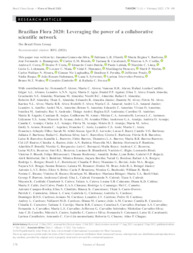Brazilian Flora 2020: Leveraging the power of a collaborative scientific network.
Brazilian Flora 2020: Leveraging the power of a collaborative scientific network.
Summary: The shortage of reliable primary taxonomic data limits the description of biological taxa and the understanding of biodiversity patterns and processes, complicating biogeographical, ecological, and evolutionary studies. This deficit creates a significant taxonomic impediment to biodiversity research and conservation planning. The taxonomic impediment and the biodiversity crisis are widely recognized, highlighting the urgent need for reliable taxonomic data. Over the past decade, numerous countries worldwide have devoted considerable effort to Target 1 of the Global Strategy for Plant Conservation (GSPC), which called for the preparation of a working list of all known plant species by 2010 and an online world Flora by 2020. Brazil is a megadiverse country, home to more of the world's known plant species than any other country. Despite that, Flora Brasiliensis, concluded in 1906, was the last comprehensive treatment of the Brazilian flora. The lack of accurate estimates of the number of species of algae, fungi, and plants occurring in Brazil contributes to the prevailing taxonomic impediment and delays progress towards the GSPC targets. Over the past 12 years, a legion of taxonomists motivated to meet Target 1 of the GSPC, worked together to gather and integrate knowledge on the algal, plant, and fungal diversity of Brazil. Overall, a team of about 980 taxonomists joined efforts in a highly collaborative project that used cybertaxonomy to prepare an updated Flora of Brazil, showing the power of scientific collaboration to reach ambitious goals. This paper presents an overview of the Brazilian Flora 2020 and provides taxonomic and spatial updates on the algae, fungi, and plants found in one of the world's most biodiverse countries. We further identify collection gaps and summarize future goals that extend beyond 2020. Our results show that Brazil is home to 46,975 native species of algae, fungi, and plants, of which 19,669 are endemic to the country. The data compiled to date suggests that the Atlantic Rainforest might be the most diverse Brazilian domain for all plant groups except gymnosperms, which are most diverse in the Amazon. However, scientific knowledge of Brazilian diversity is still unequally distributed, with the Atlantic Rainforest and the Cerrado being the most intensively sampled and studied biomes in the country. In times of ?scientific reductionism?, with botanical and mycological sciences suffering pervasive depreciation in recent decades, the first online Flora of Brazil 2020 significantly enhanced the quality and quantity of taxonomic data available for algae, fungi, and plants from Brazil. This project also made all the information freely available online, providing a firm foundation for future research and for the management, conservation, and sustainable use of the Brazilian funga and flora.
Publication year: 2022
Types of publication: Journal article
Keywords: Biodiversidade, Taxonomia
Observation
Some of Embrapa's publications are published as ePub files. To read them, use or download one of the following free software options to your computer or mobile device. Android: Google Play Books; IOS: iBooks; Windows and Linux: Calibre.
Access other publications
Access the Agricultural Research Database (BDPA) to consult Embrapa's full library collection and records.
Visit Embrapa Bookstore to purchase books and other publications sold by Embrapa.

